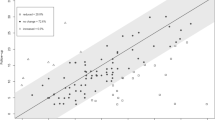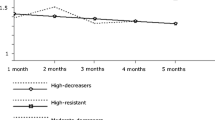Abstract
Objective
The aim of the present study was to determine whether psychopathic traits act as a predictor and/or moderator of the effectiveness of Multisystemic Therapy (MST).
Method
The sample included N = 256 adolescents (188 boys and 68 girls) referred for conduct problems, randomized to MST or Treatment As Usual (TAU). The mean age was 16 years (SD = 1.31). Assessments were carried out before and immediately after treatment (6 months later). Three psychopathic traits (callous/unemotional traits, narcissism, and impulsiveness) were assessed with parent reports. Adolescents and parents were informants on externalizing problems.
Results
MST was more effective than TAU in decreasing externalizing problems for the “lower callous/unemotional” and “lower narcissism” group, but not for the “high callous/unemotional” and “high narcissism” group (moderators). Impulsiveness was found to predict more post-treatment externalizing problems rated by adolescents (predictor), but not more post-treatment externalizing problems rated by parents.
Conclusions
These findings point out the clinical relevance of adequately assessing psychopathic traits in adolescents referred for treatment of antisocial behaviour, and identifying those adolescents who show high levels of these traits. It is important to tailor MST specifically to meet the needs of juveniles with high levels of callous/unemotional traits and high levels of narcissism to obtain the same level of effectiveness as with juveniles scoring lower on these traits.



Similar content being viewed by others
Notes
Because reliance on sample specific distributions of psychopathic traits may limit the generalizability of the findings, we conducted additional analyses using the results of the only study by Roose et al. (2009) that assessed the APSD and ICU in a Dutch (community) sample of adolescents (n = 455). In these analyses we used a cut off score that was based on the criterion of one standard deviation above the mean provided by this study to indicate the “high psychopathy” group (whereas the rest was the “lower psychopathy” group). Given the fact that this was a convenience sample, these scores cannot be considered norm scores, but the consistency of the results across analyses conducted with different cut off scores would increase confidence in the presented results. The additional analyses indeed showed a similar pattern of findings. More impulsiveness at pretest was found to predict more externalizing problems after treatment as rated by parents as well as adolescents (F = 6.03, p < 0.05 and F = 12.93, p < 0.01, respectively). Callous/unemotional traits and narcissism moderated the effect of intervention on externalizing problems rated by parents as well as adolescents (F = 4.48, p < 0.05 and F = 7.54, p < 0.01 for callous/unemotional traits, respectively; F = 11.95, p < 0.01 and F = 6.01, p < 0.05 for narcissism, respectively). Detailed information regarding these additional analysis is available from the corresponding author.
References
Achenbach, T. M. (1991a). Manual for the child behavior checklist and 1991 CBCL profile. Burlington: University of Vermont, Department of Psychiatry.
Achenbach, T. M. (1991b). Manual for the youth self-report and 1991 YSR profile. Burlington: University of Vermont, Department of Psychiatry.
Asscher, J. J., Deković, M., Van der Laan, P. H., Prins, P. J. M., & Van Arum, S. (2007). Implementing randomized experiments in criminal justice settings: An evaluation of multisystemic therapy (MST) in the netherlands. Journal of Experimental Criminology, 3, 113–129.
Asscher, J.J., Deković, M., Manders, W.A., Van der Laan, P.H., Prins, P.J.M., & Dutch MST Cost Effectiveness Research Group (2012). A randomized controlled trial of the effectiveness of Multisystemic Therapy in The Netherlands: Post-treatment changes and moderator effects. Manuscript submitted for publication.
Bijttebier, P., & Decoene, S. (2009). Assessment of psychopathic traits in children and adolescents: Further validation of the Antisocial Process Screening Device and the Childhood Psychopathy Scale. European Journal of Psychological Assessment, 25, 157–163.
Butler, S., Baruch, G., Hickey, N., & Fonagy, P. (2011). A randomized controlled trial of Multisystemic Therapy and a statutory therapeutic intervention for young offenders. Journal of the American Academy of Child and Adolescent Psychiatry, 50, 1220–1235.
Cooke, D. J., Michie, C., & Hart, S. (2006). Facets of clinical psychopathy: Toward clearer measurement. In C. J. Patrick (Ed.), The handbook of psychopathy (pp. 91–106). New York: Guilford Press.
Curry, J., Rohde, P., Simons, A., Silva, S., Vitiello, B., Kratochvil, C., et al. (2006). Predictors and moderators of acute outcome in the treatment for adolescents with depression study (TADS). Journal of the American Academy of Child and Adolescent Psychiatry, 45, 1427–1439.
Deković, M., Asscher, J. J., Manders, W. A., Prins, P. J. M., & Van der Laan, P. H. (2012). Within-Intervention Change: Mediators of Intervention Effects During Multisystemic Therapy. Journal of Consulting and Clinical Psychology, 4, 574–587.
Dillard, C.L., Salekin, R.T., Randall, T., Barker, E.D., & Grimes, R.D. (2012). Psychopathy in adolescent offenders: An item response theory study of the Antisocial Process Screening Device-self report and the Psychopathy checklist: Youth version. Personality Disorders: Theory, Research, and Treatment, X, XX
Dolan, M., & Doyle, M. (2007). Psychopathy: Diagnosis and implications for treatment. Psychiatry, 6, 404–408.
Essau, C.A., Sasagawa, S., & Frick, P.J. (2006). Callous-unemotional traits in a community samples of adolescents. Assessment, 13, 454–469. doi: 10.1177/1073191106287354
Frick, P. J. (2004). Inventory of callous–unemotional traits. New Orleans: Unpublished rating scale, University of New Orleans.
Frick, P. J., Cornell, A. H., Bodin, S. D., Dane, H. E., Barry, C. T., & Loney, B. R. (2003). Callous-unemotional traits and developmental pathways to severe conduct disorder. Developmental Psychology, 39, 246–260.
Frick, P. J., & Dickens, C. (2006). Current perspectives on conduct disorder. Current Psychiatry Reports, 8, 59–72.
Frick, P. J., & Hare, R. D. (2001). The antisocial processes screening device. Toronto: Multi-Health Systems.
Frick, P. J., & White, S. F. (2008). Research review: The importance of callous-unemotional traits for developmental models of aggressive and antisocial behavior. Journal of Child Psychology and Psychiatry, 49, 359–375.
Gardner, F., Hutchings, J., Bywater, T., & Whitaker, C. (2010). Who benefits and how does it work? Moderators and mediators of outcome in an effectiveness trial of a parenting intervention. Journal of Clinical Child and Adolescent Psychology, 39, 568–580.
Graham, J. W. (2009). Missing data analysis: Making it work in the real world. Annual Review of Psychology, 60, 549–576.
Gretton, H. M., Hare, R. D., & Catchpole, R. E. H. (2004). Psychopathy and offending from adolescence to adulthood: A 10-year follow-up. Journal of Consulting and Clinical Psychology, 72, 636–645.
Hare, R. D., Hart, S. D., & Harpur, T. J. (1991). Psychopathy and the DSM-IV criteria for antisocial personality disorder. Journal of Abnormal Psychology, 100, 391–398.
Hawes, D. J., & Dadds, M. R. (2005). The treatment of conduct problems in children with callous-unemotional traits. Journal of Consulting and Clinical Psychology, 73, 737–741.
Henggeler, S. W. (2011). Efficacy studies to large-scale transport: The development and validation of Multisystemic Therapy programs. Annual Review of Clinical Psychology, 7, 351–381.
Henggeler, S. W., Clingempeel, W. G., Brondino, M. J., & Pickrel, S. G. (2002). Four-year followup of multisystemic therapy with substance abusing and dependent juvenile offenders. Journal of the American Academy of Child and Adolescent Psychiatry, 41, 868–874.
Henggeler, S. W., Schoenwald, S. K., Borduin, C. M., Rowland, M. D., & Cunningham, P. B. (1998). Multisystemic treatment of antisocial behavior in children and adolescents. New York: Guilford.
Kimonis, E. R., Frick, P. J., Skeem, J. L., Marsee, M. A., Cruise, K., Munoz, L. C., et al. (2008). Assessing callous-unemotional traits in adolescent offenders: Validation of the Inventory of Callous-Unemotional Traits. International Journal of Law and Psychiatry, 31, 241–252.
Kraemer, H. C., Wilson, G. T., Fairburn, C. G., & Agras, W. S. (2002). Mediators and moderators of treatment effects in randomized clinical trials. Archives of General Pychiatry, 59, 877–883.
Langton, C. M., Barbaree, H. E., Harkins, L., & Peacock, E. J. (2006). Sex offender’s response to treatment and its association with recidivism as a function of psychopathy. Sexual Abuse: A Journal of Research and Treatment, 18, 99–120.
Letourneau, E. J., Henggeler, S. W., Boduin, C. M., Schewe, P. A., McCart, M. R., et al. (2009). Multisystemic therapy for juvenile sexual offenders: 1-year results from a randomized effectiveness trial. Journal of Family Psychology, 23, 89–102.
Loeber, R., Burke, J., & Pardini, D. A. (2009). Perspectives on oppositional defiant disorder, conduct disorder, and psychopathic features. Journal of Child Psychology and Psychiatry, 50, 133–142.
Newman, J. P., & Wallace, J. F. (1993). Diverse pathways to deficient self-regulation: Implications for disinhibitory psychopathology in children. Clinical Psychology Review, 13, 688–720.
Ogden, T., & Halliday-Boykins, C. A. (2004). Multisystemic treatment of antisocial adolescents in Norway: Replication of clinical outcomes outside of the US. Child and Adolescent Mental Health, 9, 77–83.
Oxford, M., Cavell, T. A., & Hughes, J. N. (2003). Callous/unemotional traits moderate the relation between ineffective parenting and child externalizing problems: A partial replication and extension. Journal of Clinical Child and Adolescent Psychology, 32, 577–585.
Pardini, D., & Loeber, R. (2008). Interpersonal callousness trajectories across adolescence: Early social influences and adult outcomes. Criminal Justice and Behavior, 35, 173–196.
Poythress, N. G., Douglas, K., Falkenbbach, D., Cruise, K., Lee, Z., Murrie, D. C., & Vitacco, M. (2006). Internal consistency and reliability of the self-report Antisocial Process Screening Device. Assessment, 13, 107–113.
Roose, A., Bijttebier, P., Decoene, S., Claes, L., & Frick, P. (2009). Assessing the affective features of psychopathy in adolescence: A further validation of the inventory of callous and unemotional traits. Assessment, 17, 44–57. doi: 10.1177/1073191109344153
Salekin, R. T., Rosenbaum, J., & Lee, Z. (2008). Child and adolescent psychopathy: Stability and change. Psychiatry, Psychology, and Law, 15, 224–236.
Salekin, R. T., Worley, C. B., & Grimes, R. D. (2010). Treatment of psychopathy: A review and brief introduction to the mental models approach. Behavioral Sciences & the Law, 28, 235–266.
Seagrave, D., & Grisso, T. (2002). Adolescent development and the measurement of juvenile psychopathy. Law and Human Behavior, 26, 219–239.
Sundell, K., Hansson, K., Löfholm, C. A., Olsson, T., Gustle, L.-H., & Kadesjö, C. (2008). The transportability of Multisystemic therapy to Sweden: short-term results from a randomized trial of conduct-disordered youths. Journal of Family Psychology, 22, 550–560.
Supplee, L. H., Kelly, B. C., MacKinnin, D. M., & Barofsky, M. Y. (2013). Introduction to the Special Issue: Subgroup analysis in prevention and intervention research. Prevention Science, 14, 107–110.
Verhulst, F.C., Koot, J.M., Akkerhuis, G.W., & Veerman, J.W. (1990). Praktische handleiding voor de CBCL . [CBCL manual] Van Gorcum, Assen/Maastricht.
Vitacco, M. J., Rogers, R., & Neumann, C. S. (2003). The antisocial process screening device: An examination of its construct and criterion-related validity. Assessment, 10, 143–150.
Wang, R., Lagakos, S. W., Ware, J. H., Hunter, D. J., & Drazen, J. M. (2007). Statistics in medicine — Reporting of subgroup analyses in clinical trials. The New England Journal of Medicine, 357, 2189–2194.
White, S. F., Cruise, K. R., & Frick, P. J. (2009). Differential correlates to self-report and parent report of callous-unemotional traits in a sample of juvenile sex offenders. Behavioral Science and the Law, 27, 910–928.
Wootton, J. M., Frick, P. J., Shelton, K. K., & Silverthorn, P. (1997). Ineffective parenting and childhood conduct problems: The moderating role of callous– unemotional traits. Journal of Consulting and Clinical Psychology, 65, 301–308.
Author information
Authors and Affiliations
Corresponding author
Rights and permissions
About this article
Cite this article
Manders, W.A., Deković, M., Asscher, J.J. et al. Psychopathy as Predictor and Moderator of Multisystemic Therapy Outcomes among Adolescents Treated for Antisocial Behavior. J Abnorm Child Psychol 41, 1121–1132 (2013). https://doi.org/10.1007/s10802-013-9749-5
Published:
Issue Date:
DOI: https://doi.org/10.1007/s10802-013-9749-5




